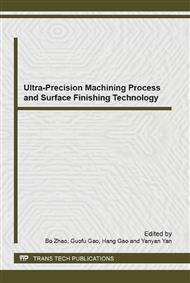p.58
p.63
p.68
p.72
p.76
p.80
p.84
p.88
p.93
Optimization of Milling Parameters of CFRP for Surface Roughness Using Taguchi Design Method
Abstract:
End milling is conducted on carbon fiber reinforced plastics (CFRP) by using a diamond coated cemented carbide tool. Taguchi design method is employed to investigate the influence of cutting speed, feed rate and depth of cut on surface roughness. In Taguchi method, a three level orthogonal array has been used to determine the S/N ratio. Analysis of variance (ANOVA) and pareto diagram are used to determine the most significant milling parameters affecting the surface roughness. The results indicate that only the depth of cut has great statistical significance on the surface roughness, while the influences of cutting speed and feed are negligible. SEM micrographs shows that with the increase of depth of cut, a great deal epoxy resin will adhere to the finished surface. The greatest S/N ratio (1.46dB) is obtained during the validation experiment with optimum milling parameters.
Info:
Periodical:
Pages:
76-79
Citation:
Online since:
October 2014
Authors:
Price:
Сopyright:
© 2014 Trans Tech Publications Ltd. All Rights Reserved
Share:
Citation:


